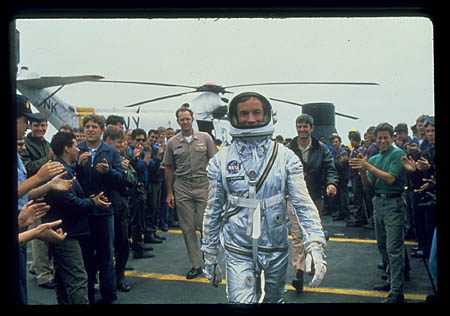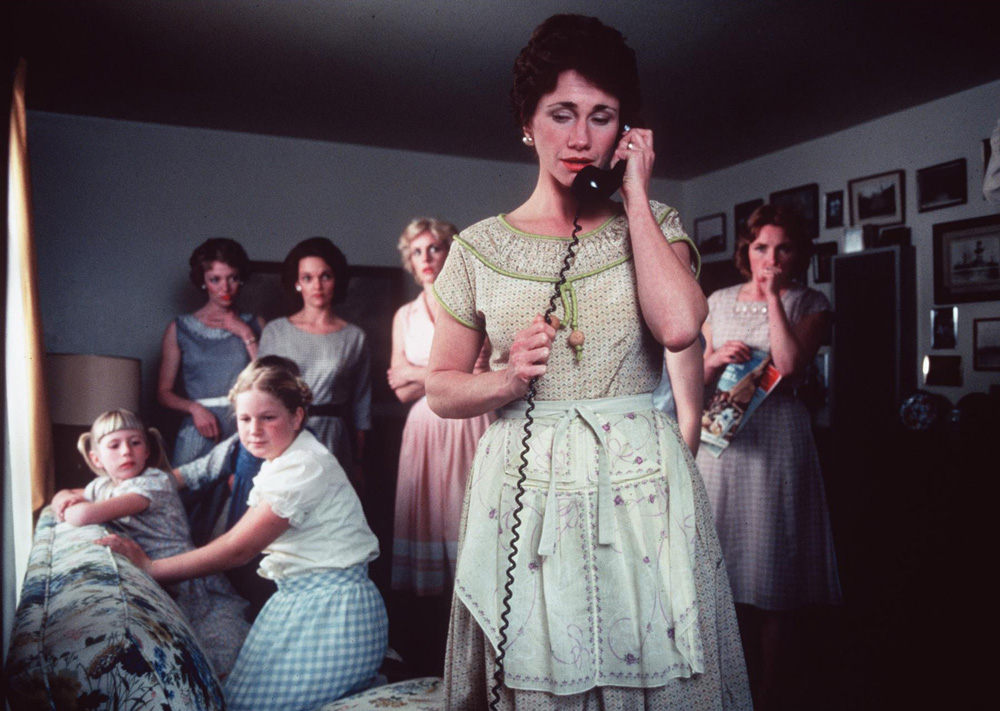
(c)1983 The Ladd Company. All.rights reserved.
What is Philip Kaufman's adaptation and directing technique of "The Right Stuff" based on historical facts?
2020.03.27
Grissom was unhappy
Grissom (*20) was the second to fly aboard Mercury Redstone 4 (Liberty Bell 7) on July 21, 1961. It was basically a repeat of Shepard's suborbital flight, and received little attention from the media.
Although the flight itself was successful, the explosion bolt of the newly installed emergency escape hatch activated prematurely, perhaps due to an operational error or malfunction (*21) when landing on the water. Seawater poured into the ship, and the capsule sank to the ocean floor, along with valuable data. Grissom nearly drowns, but is barely rescued by a helicopter.
He was vilified by the press and was not invited to the White House. There was no parade, just a Distinguished Service Award presented by NASA Administrator James E. Webb in a makeshift tent on the runway at Patrick Air Force Base. Grissom's wife, Betty (Veronica Cartwright), becomes angry with Shepard.

"The Right Stuff" (c) 1983 The Ladd Company. All.rights reserved.
The Air Force test pilots make fun of Grissom's mistakes, but Yeager praises him. Kaufman implies that "he also wanted to go to space." As Yeager stands in the ruins of the Happy Bottom Riding Club, which had burned down in a mysterious fire, his wife Glenys says to him, "I can't stand a man who lives for old stories." After Grissom recorded Mach 2.44 in the X-1A, he hadn't attempted any new records.
*20 Grissom is introduced in the narration at the end of the movie, but he is brilliant.Apollo 1He was selected as the commander of the 1967 Apollo 1 SpaceX 2000. However, he died in a fire during training on January 27, 1967. North American Space Agency, which designed and manufactured the Apollo 1 command module, recommended using a hatch that opened outward like the one used in the Mercury capsule and could be blown open with explosive bolts in an emergency, and the astronauts also recommended this design. However, NASA, based on their experience with Liberty Bell 7, on which Grissom was aboard, rejected this suggestion and adopted a hatch that opened inward with no explosive bolts. If this had been the design advocated by the manufacturer, it is highly likely that the fatal accident could have been prevented.
*21 Kaufman left the cause of this a mystery, but it was discovered the following year that it was actually a malfunction. When Schiller returns on Mercury 8 (Sigma 7), manually blow up the hatch.experimentThe result was that the hands would always be bruised, clearing Grissom's Notorious. Incidentally, the sunken capsule was raised from the ocean floor at a depth of 4,500m on July 20, 1999.
*22 The scene where the ``Happy Bottom Riding Club'' catches fire seems sudden to Japanese people who are not aviation buffs, as there is no background explanation. It all began in 1952 when Brigadier General Stanley Holtner, who had arrived at Edwards Air Force Base, and Pancho's sled did not match. Holtner was a strict man who believed the rumors that Pancho was pimping soldiers into prostitution (as Jeff Goldblum's line ``Do you really want to ride a horse?''). He asks the FBI to investigate Pancho's background, but they find no evidence of prostitution.
Eventually, the Air Force orders Pancho's eviction because his land will interfere with plans to expand the runway. Pancho filed a lawsuit against the government, but on November 13, 1953, during the trial, Pancho's dance hall, restaurant, motel, bungalow, bar, stable, and home were destroyed. Everything was burnt down. The fire department concluded that the cause of the fire was simultaneous arson at multiple locations using a combustion accelerator, but the culprit has not yet been identified. Also, the runway expansion, which was supposed to be the reason for her eviction, never actually took place.
Glenn's orbital flight
On August 7, 1961, the Soviet Union orbited the Earth 17 times with Vostok 2, piloted by Gherman Titov. The US government was shocked by this again and felt that they had to make an orbital flight a success at all costs. They decided to use the Atlas rocket, which still had safety concerns, and ordered Glenn to fly it.
Naturally, the media and politicians paid a lot of attention to Glenn. At that time, the concept of human rights and privacy was much weaker than it is now, so reporters flocked to the aviator's home in droves. Particularly brazen was Johnson, who became vice president. He plans to use his wife Annie (Mary Jo Deschanel), who is waiting for Glenn's launch, to make himself known on national television.
However, Annie stubbornly refused the Vice President's visit. This is because she suffers from a stuttering complex and was afraid of having it known on national television. The vice president, through the NASA administrator, pressures Glenn to convince his wife, but Glenn says, ``If you don't want me in the house, I don't care! Let them go. No matter who you are, don't even put a finger in our house!'' I called Annie. This scene is one of the most moving scenes in the play, and it is largely true.

"The Right Stuff" (c) 1983 The Ladd Company. All.rights reserved.
Glenn was launched by Mercury Atlas 6 (Friendship 7) on February 20, 1962. Communication with him is through a control center at Cape Canaveral and tracking stations at 18 locations around the world. Cooper was the communications liaison at one of the stations, Mutia, Western Australia . Australians were very supportive, with most of the residents of Bath and Rockingham lighting up lights at midnight to cheer Glen up. This situation has actually been confirmed from space.
But Kaufman adds a little creativity here. This is the scene where the Aborigines hear Cooper's story, sense Glen's crisis, and begin to pray. Red sparks fly up from the flames of their bonfires.
Meanwhile, Glenn is in orbit, observing the Earth through the capsule's window (which had been installed since the previous flight). Suddenly, the capsule becomes covered in glowing particles. In the movie, the scene is beautifully depicted as if the red sparks from the bonfires set by the Aborigines had reached the universe. Some people may think it's a lie, but it's based on fact, and Glenn called it a firefly (*23).

"The Right Stuff" (c) 1983 The Ladd Company. All.rights reserved.
Friendship 7 was scheduled to orbit the Earth for more than seven times, but during its second orbit, the sensor for the airbag that cushions the impact during water landing showed an abnormal value. The mission control center determined that the capsule's heat shield was about to fall off, and decided to terminate the mission after three orbits. Glenn was initially unaware of what was happening, but when the mission control center ordered him to re-enter without detaching the retropropulsion rocket, he realized the gravity of the situation. Mission control had hoped that the tie ropes securing the device would prevent the heat shield from falling off.
Glenn becomes anxious and frightened when he sees fragments of a flaming retropropelling rocket passing outside the window, and frantically hums his habit of ``Yodobashi Camera Song'' (correctly ``Republic Hymn''). I try to calm down. However, at that moment, the capsule enters the ionosphere and contact with the ground is temporarily blacked out.
In the end, it turned out that there was nothing wrong with the heat shield, and that the cause was a sensor malfunction. Glenn, who returned safely, was hailed as even more of a hero than Shepard, and was praised by the whole of America, with large parades held in Washington DC and New York.
*23 Although not depicted in the movie, the true identity of this space firefly was created by the fourth Carpenter.Mercury Atlas 7 (Aurora 7)It is revealed in The Mercury capsule and its crew's space suits includeWater-cooled heat exchange systemwas installed so that cooling water could be discharged overboard. When the capsule enters Earth's shadow, this cooling water condenses on the hull and quickly freezes. When the capsule emerges from the shadows, the heat from the sun causes the frost to flake off and float around the capsule, reflecting the sunlight and making it sparkle.
This was confirmed when Carpenter deliberately knocked the frost off the capsule wall by tapping on it. However, he becomes so absorbed in this play that he consumes a large amount of the spaceship's fuel, and returns home in a very dangerous condition.
Incidentally, there is an urban legend that this space firefly was ``an astronaut's urine released overboard.'' However, what was installed after the second Liberty Bell 7 was a simple urine bag inside the spacesuit.Mercury Atlas 8 (Sigma 7)In this case, a pump was added to suck out the urine from the bladder into a storage bag outside the space suit, but basically the urine was kept in the capsule (as a general rule, the feces was just held in).
The sixth person, Cooper, was also given the task of taking samples from a storage bag with a dropper at regular intervals and transferring them to another container as a record of changes in physical condition. However, this process did not go well, and they ended up floating inside the capsule as small spheres. This troublesome urine overboard discharge function was added in the nextgemini planTherefore, it is impossible that this is the cause of the space fireflies in the Mercury project.
However, the problem of waste disposal isapollo programHowever, since the issue was not fundamentally resolved, I ended up leaving behind some dirty anecdotes. Among them, the most notable areApollo 9Astronaut Russell Schweikert recalled, ``The most beautiful sight I saw in orbit was when I dumped my urine outside the command module at sunset.'' In other words, the same phenomenon that occurred with the cooling water in Project Mercury did occur with the urine released overboard. The truth is that this episode was confused with the space fireflies described by Glenn.
Another theory is that cosmic radiation hits the retina of the eye, causing the sense of light. This phenomenon has actually been observed on the Space Shuttle and the International Space Station, and is called the "flash reaction." However, it is not only visible outside the window of a spaceship, nor does it look like a swarm of fireflies dancing.
*24 The setting that Glenn has a habit of humming is a creation of Kaufman, but he foreshadows it by having Cooper say ``Stop humming!'' in the bathroom during a semen test at the hospital. The songs that were being sung in the toilet were:United States Air Force song"and"marine corps anthem”.

